|
Magic Realism has emerged as one of the more intriguing art terms
over the past few decades. What exactly is Magic Realism? A close
look at German art of the Weimar period and reevaluations of the
impact of the Surrealist movement on both European and American
artists during the 1930s and 40s are important exercises in
establishing a clear identity for Magic Realism as an art movement.
Also important is to recognize that both style and content work
together to create the "magic" in a Magic Realism painting.
Many discussions about Magic Realism begin with historical
references to the German writer Dr. Franz Roh and cite German art in
the Weimar years as the source of this type of art. However, Weimar
art was a mixed bag and an extensive review of this period is
required to appreciate the complex dynamics that influenced German
artists. Many artists transitioned between styles, adapting their
approach as social, political and economic environments changed. Magic Realism can be
identified in many paintings produced
in Germany during this era, but it is difficult to maintain that a
cohesive movement evolved. It is more accurate to describe Weimar
art as a melting pot of styles which provided sporadic works of Magic Realism
and which was connected to a broader movement outside
Germany.
Franz Roh coined the term Magic Realism in
Nach-expressionsmus, magisher Realismus, Probleme der neuesten
europaischer Malerei, published in 1925. In his book Roh
carefully detailed the stylistic
characteristics of a new
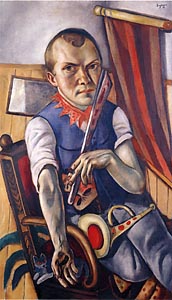 art
movement which he called Post-Expressionism, and contrasted them
with Expressionism. He gave this new type of art the byname
Magic Realism, in order to suggest what he considered its special
evocative qualities.
In June 1925, Gustav Hartlaub opened an exhibition Die Neue
Sachlichkeit in Mannheim.
Initially Roh and Hartlaub
seemed to focus on similar art when first commenting on
Post-Expressionism, an art that was moving away from both abstraction and
emotionally charged imagery. Hartlaub initially emphasized that he saw
a division of two separate wings within this type of art, a
classically oriented right wing and a socially critical left one. Roh helped
to organize the exhibition, but he avoided
supporting Hartlaub's bipolar outlook. Roh felt instead that there was a
singular
movement away from Expressionism, which had many manifestations and
which was also evident in
other European countries. Hartlaub first tried to organize the exhibition
in 1923 but hyperinflation made that impossible. In his second
attempt of 1925, he downplayed the bipolar concept and emphasized
that the exhibition was not promoting any particular style of art.
Paintings from Socially Critical
painters like Otto Dix and George Grosz were included, yet Hartlaub
selected works that were neither controversial nor
provocative. The exhibition received support in the press and made a profound impression on
the public. Neue Sachlichkeit (The New Objectivity or
New Sobriety) subsequently became a label applied by many writers
when referring to typical styles of the Weimar period. Soon after a
homogeneous style
of Neue Sachlichkeit developed both in Germany and to an extent in
other European
countries. It became palatable to bourgeois
tastes and which shed the last vestiges of Expressionism. Magic
Realism, while sharing many similarities with Neue Sachlichkeit,
developed as a disinct movement. evolving throughout Europe and the
Americas in subsequent decades. art
movement which he called Post-Expressionism, and contrasted them
with Expressionism. He gave this new type of art the byname
Magic Realism, in order to suggest what he considered its special
evocative qualities.
In June 1925, Gustav Hartlaub opened an exhibition Die Neue
Sachlichkeit in Mannheim.
Initially Roh and Hartlaub
seemed to focus on similar art when first commenting on
Post-Expressionism, an art that was moving away from both abstraction and
emotionally charged imagery. Hartlaub initially emphasized that he saw
a division of two separate wings within this type of art, a
classically oriented right wing and a socially critical left one. Roh helped
to organize the exhibition, but he avoided
supporting Hartlaub's bipolar outlook. Roh felt instead that there was a
singular
movement away from Expressionism, which had many manifestations and
which was also evident in
other European countries. Hartlaub first tried to organize the exhibition
in 1923 but hyperinflation made that impossible. In his second
attempt of 1925, he downplayed the bipolar concept and emphasized
that the exhibition was not promoting any particular style of art.
Paintings from Socially Critical
painters like Otto Dix and George Grosz were included, yet Hartlaub
selected works that were neither controversial nor
provocative. The exhibition received support in the press and made a profound impression on
the public. Neue Sachlichkeit (The New Objectivity or
New Sobriety) subsequently became a label applied by many writers
when referring to typical styles of the Weimar period. Soon after a
homogeneous style
of Neue Sachlichkeit developed both in Germany and to an extent in
other European
countries. It became palatable to bourgeois
tastes and which shed the last vestiges of Expressionism. Magic
Realism, while sharing many similarities with Neue Sachlichkeit,
developed as a disinct movement. evolving throughout Europe and the
Americas in subsequent decades.
A review of Hautlaub's Die Neue Sachlichkeit exhibition catalog
reveals that almost half of paintings presented were produced by
either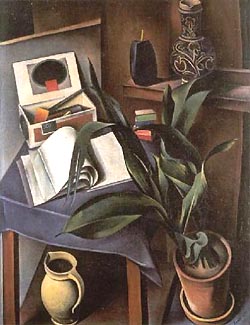 Max Beckmann or by
painters associated with Munich (Schrimpf, Kanoldt, Mense, Erbsloeh,
Schulz-Matan and Daveringhausen).
Franz Roh lived in Pasig, near Munich and saw the potential for Magic Realism
in the work of its local artists. However, these artists dispersed by 1926,
and Munich lost its importance as a major art center. Meanwhile Hartlaub
felt Beckmann was one of Germany's most important artist. However, as
early as 1923 Beckmann shifted away from his Magic Realist phase toward
individualistic styles, ultimately integrating
diverse influences which included
Cezanne, Grünewald,
Brueghel and medieval stained glass.
Max Beckmann or by
painters associated with Munich (Schrimpf, Kanoldt, Mense, Erbsloeh,
Schulz-Matan and Daveringhausen).
Franz Roh lived in Pasig, near Munich and saw the potential for Magic Realism
in the work of its local artists. However, these artists dispersed by 1926,
and Munich lost its importance as a major art center. Meanwhile Hartlaub
felt Beckmann was one of Germany's most important artist. However, as
early as 1923 Beckmann shifted away from his Magic Realist phase toward
individualistic styles, ultimately integrating
diverse influences which included
Cezanne, Grünewald,
Brueghel and medieval stained glass.
Franz Roh stated that Magic Realism should not simply bring back
"the more neutral art of Courbet and Leibl". He opposed any revival
of 19th Century academic art, feeling that artists should avoid
regression. Within the
Munich group
Kanoldt,
Schrimpf and Mense each had connections
with Italian art, both through the
Deutsch-Römer artists of
the 1800s and also through a number of Italian
contemporary artists, including both Carlo Carra
and Giorgio de Chirico.
Influences of De Chirico can also
be seen in the works of many German artists during the early 1920s,
including George Grosz, Anton Raederscheidt and Max Ernst. An even broader
influence on German Weimar art was that of
Henri Rousseau, the primitivist French painter.
Naive aspects
are apparent in the works of German artists from several different
regions,
including those by Max Beckmann,
Wilhelm Schnarrenberger,
Carl Grossberg,
Georg Scholz,
Ernst Thoms,
Grethe Jüergens,
Erich Wegner,
Walter Spies,
Niklaus Stoeklin and
Adolf Dietrich
(known as the German Rousseau). Inclusion of naive elements was an important strategy used by artists to move away from
Expressionism. It should be
viewed as one of the most significant categories of Magic Realism
within Weimar art. For many artists a
naive style proved to be a short termed or transitional phase, but
many early works of the Magic Realism movement contained
naive elements.
The postwar period saw the spread of
a counter-Modernist movement in the arts, known as the
Return to Order (or Call to O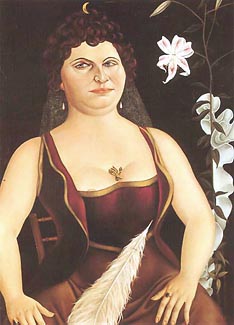 rder), which
included the revival of many traditional painting
techniques. In Italy Il
Novecento Italiano in
particular stood out in this regard, through the paintings of
Felice Casorati,
Achille Funi, Ubaldo Oppi,
Gino Severini and
Antonio Donghi., as did works by
Andre Derain,
Felix Vallotton and
Auguste Herbin in France. Around
1925 a strong tendency toward precision and illusionism emerged within
German art. This was partially due to the success of Hautlaub's
exhibition but the trend was also supported by a steady influx of new
artists. Many of these artists were interested in early Renaissance
and adopted techniques based on careful studies of the Flemish and German
Masters. By the mid 1920s numerous intensely detailed paintings
began to appear, sometimes exhibiting an almost unnatural realism.
Often the "magic" of these paintings was embedded in the details of
the work. Important variations of Magic
Realism developed from this tendency. The paintings of
Franz Radziwill are good examples, as he often instilled an
eerie or ominous atmosphere into his works. Equally notable were
architectonic paintings by Carl Grossberg, who sometimes added
uncanny elements to his works such as bats, birds or apes. Meanwhile
Christian Schad studied Raphael and other Italian Masters while
living in Naples. Schad's paintings consistently exhibited a cool and
almost
photographic sharpness, but often included both naive
and metaphorical elements. His art is often cited by art historians
and writers as
the quintessential art of Neue Sachlichkeit. Many of his Schad's paintings exhibit
intangible qualities connecting him to Magic Realism. rder), which
included the revival of many traditional painting
techniques. In Italy Il
Novecento Italiano in
particular stood out in this regard, through the paintings of
Felice Casorati,
Achille Funi, Ubaldo Oppi,
Gino Severini and
Antonio Donghi., as did works by
Andre Derain,
Felix Vallotton and
Auguste Herbin in France. Around
1925 a strong tendency toward precision and illusionism emerged within
German art. This was partially due to the success of Hautlaub's
exhibition but the trend was also supported by a steady influx of new
artists. Many of these artists were interested in early Renaissance
and adopted techniques based on careful studies of the Flemish and German
Masters. By the mid 1920s numerous intensely detailed paintings
began to appear, sometimes exhibiting an almost unnatural realism.
Often the "magic" of these paintings was embedded in the details of
the work. Important variations of Magic
Realism developed from this tendency. The paintings of
Franz Radziwill are good examples, as he often instilled an
eerie or ominous atmosphere into his works. Equally notable were
architectonic paintings by Carl Grossberg, who sometimes added
uncanny elements to his works such as bats, birds or apes. Meanwhile
Christian Schad studied Raphael and other Italian Masters while
living in Naples. Schad's paintings consistently exhibited a cool and
almost
photographic sharpness, but often included both naive
and metaphorical elements. His art is often cited by art historians
and writers as
the quintessential art of Neue Sachlichkeit. Many of his Schad's paintings exhibit
intangible qualities connecting him to Magic Realism.
An
important characteristic of Magic Realism is ultrasharp focus.
Sharp detail is seen throughout the paintings, including in the
background. Highly defined and even exaggerated detail may also
appear selectively in areas that the artist wishes to accentuate.
The overall effect is to move the viewer's attention all over the
pai,%201928%201b.jpg) nting, before allowing the totality of the composition to be
comprehended. The same effect occurs frequently in naive paintings
and occurred in many works by the Renaissance German and Flemish Masters. Another characteristic often seen in Magic
Realism paintings is an almost unnatural clarity. This was achieved
by flattened tonality and idealized
lighting, by limitations on atmospheric effects and by
suppressing shadows. Many Magic Realism paintings also exhibit a false
naturalism. nting, before allowing the totality of the composition to be
comprehended. The same effect occurs frequently in naive paintings
and occurred in many works by the Renaissance German and Flemish Masters. Another characteristic often seen in Magic
Realism paintings is an almost unnatural clarity. This was achieved
by flattened tonality and idealized
lighting, by limitations on atmospheric effects and by
suppressing shadows. Many Magic Realism paintings also exhibit a false
naturalism.
A focus on objects helped to define the work of German artists art
during the Weimar years. Franz Roh stated that Magic Realism "employs
various techniques that endow all things with a deeper meaning and
reveal mysteries that always threaten the secure tranquility of
simple and ingenuous things... it is a question of
representing before our eyes, in an intuitive way, the fact, the
interior figure, of the exterior world".
He spoke of a "gegenstandlichkeit', or a sensitivity to objects.
Many of Roh's comments about Magic Realism stem from his interest in
phenomenology, a philosophical methodology which studies
structures within our consciousness. Roh further commented about the
emergence of Magic Realism "the autonomy of the objective
world around us was once more enjoyed; the wonder of matter that
could crystallize into objects was to be seen anew." In the
words of historian Edith Balas "They (Magic Realists) used a form of
stylization whereby the observed phenomenon was reduced to its
essence, confirming the oneness of the gestalt despite the
multiplicity of its aspects. Notwithstanding their avowed goal of
capturing the appearance of momentary phenomenon with the utmost
fidelity, their unconscious aim was to transcend the many contingent
modes of reality and create an eidos, an abstract essential
form ; therefore their realism was never quite "real", but rather a
synthesis of their perceptions expressed in the disciplined,
methodical treatment of the painted image: the experience of vision.
This phenomenon is inseparably associated with appearance as
phantasia."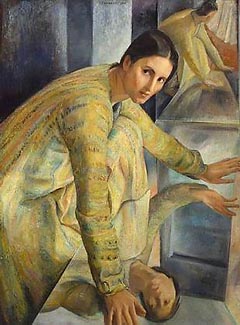
Through his comparison of
Magic Realism with Expressionism, Franz Roh defined its most important stylistic characteristics,
yet there has always been
confusion regarding its content. Some
writers have equated Magic Realism with Hartlaub's right wing of Neue Sachlichkeit.
In other instances Magic Realism has been referred to as a type of Surrealism or
as art that descended from Pittura metafisica. In his 1925 book Roh actually
detailed seven different currents as being
related to Magic Realism. Using this multifaceted outlook, Roh
envisioned a broad
movement, one which was also evident in a number of countries outside of
Germany. The multifaceted nature of Magic Realism has been
overlooked by most historians. Based on a comprehensive survey of art during the interwar period,
it is apparent that there were many paintings that aspired to
transcend a straight realism and/or to evoke cerebral musing, yet
still
displaying stylistic characteristics outlined by Roh. Following are
the most significant groupings from which Magic Realism emerged in
the four decades after World War I, and as related to Roh's multifaceted concept.
-
Classical - roughly Hartlaub's right wing. Most applicable to
Italian art, especially Il Novocento Italiano.
-
Socially Critical - the so-called Verism of Grosz, Dix, Schlicter
and others.
-
Hardened Expressionism - Beckmann, Carl Hofer, Albert Birkle and
others.
-
Metaphysical - art descending from early Metaphysical painting.
-
Naive - art influenced by Henri Rousseau or by neo-primitivism (Carra).
-
Architectonic - a broad range of art using themes of architecture
and the Metropolis, including Carl Grossberg, Charles Sheeler and
the Precisionists.
-
Illusionistic - art incorporating various illusionistic devices,
including trompe d'oeil.
-
Metaphoric - art employing a rich usage of objects metaphorically
This overall diversity was not without precedent among major art
movements. For example,
Post-Impressionism refers to a varied reaction to Impressionism in
the 1880s and 90s. Symbolism and Surrealism are both noteworthy
for considerable variations in style and content. With Magic Realism, the initial multiformity of the
early 1920s narrowed over time, as a number of variations evolved and
coalesced into regional genres, mainly in Italy, the Netherlands
and in the Americas.
In the late 1920s Magic Realism
developed in
other European countries and in the Americas. This was also the time in which Surrealism began to build up steam as an art
movement, and it soon overshadowed Magic Realism. Andre
Breton, as the foremost organizer of Surrealism, actively recruited
both in Europe and North America. His efforts did not always bear
fruit. As Fridha Kahlo bluntly put it, "I
don't paint dreams or nightmares. I paint my own reality". In France
and Belgium, artists like Pierre Roy and
Paul Delvaux, admirers of Giorgio de Chirico, produced works
that bordered on an improbable reality. Important Magic Realist
active during the 1930s included
Balthus in France,
Cagnaccio di San Pietro in Italy, Tristram
Hillier and
Edward Wadsworth in England, and
Antonio Berni in Argentina. Meanwhile Dutch
artists Carel Willink,
Raoul Hynckes,
Dick Ket and Pyke Koch
actively worked with Franz Roh's concepts to establish a tradition
of Dutch Magic Realism that lives on to our present day. Koch
provided a concise definition of the mission of the Magic Realist,
"Magic Realism is based on the representation of what is possible,
but not probable".
the time in which Surrealism began to build up steam as an art
movement, and it soon overshadowed Magic Realism. Andre
Breton, as the foremost organizer of Surrealism, actively recruited
both in Europe and North America. His efforts did not always bear
fruit. As Fridha Kahlo bluntly put it, "I
don't paint dreams or nightmares. I paint my own reality". In France
and Belgium, artists like Pierre Roy and
Paul Delvaux, admirers of Giorgio de Chirico, produced works
that bordered on an improbable reality. Important Magic Realist
active during the 1930s included
Balthus in France,
Cagnaccio di San Pietro in Italy, Tristram
Hillier and
Edward Wadsworth in England, and
Antonio Berni in Argentina. Meanwhile Dutch
artists Carel Willink,
Raoul Hynckes,
Dick Ket and Pyke Koch
actively worked with Franz Roh's concepts to establish a tradition
of Dutch Magic Realism that lives on to our present day. Koch
provided a concise definition of the mission of the Magic Realist,
"Magic Realism is based on the representation of what is possible,
but not probable".
The infatuation with the world of objects that German painters
developed was fueled by a technological revolution and the
emergence of a mass culture. At the same time, political and
economic instability during the interwar period fomented alienation and cultural
anxieties. The reaction of many artists was most evident in thir use of visual
devices which De Chirico referred as defamiliarization, or making the
ordinary seem strange or enigmatic. Thus came about the development of
"The Uncanny", an aesthetic which became as important to Magic Realism as the
sublime had been for Romanticism in the previous century. The
Uncanny was a pervasive component within much of the representational
art produced between 1920 and 1960. It should be considered an
essential component in works of Magic Realism, though in many cases
its presence is subliminal.
In the 1920s an important development in American art occurred,
which was at first referred to as Cubist Realism, then as the
Immaculate School and eventually as Precisionism. The movement
encompassed a range of styles, from abstraction to an early type of
photorealism, and covered architectural and industrial subject
matter along with the vernacular and provincial. The most prominent
of the Precisionists was Charles Sheeler, who developed a realistic style in
the late 1920s, reminiscent of Die Neue Sachlichkiet. Sheeler and
other painters associated with Precisionism were also
among the first Americans to produce Magic Realism.
In the 1920s American artist Grant Wood made
several study trips to Europe. He came away most impressed with the
precision and clarity that he saw in the works of the old Flemish
masters, especially those of Jan van Eyck and Hans Memling. He also
saw first hand the developments occurring in German
%201930%201b.jpg) contemporary art. Two distinct types of Magic Realism appear in his
work produced after 1930. First his portraits are done in the style
of the Flemish and German masters and include obvious symbolism. In
his landscapes, he often makes use of quasi-naive stylizations and
miniaturization.
Although Grant Wood is generally
considered to be one of three important Regionalist painters, many
of his
paintings are wonderful examples of Magic Realism.
contemporary art. Two distinct types of Magic Realism appear in his
work produced after 1930. First his portraits are done in the style
of the Flemish and German masters and include obvious symbolism. In
his landscapes, he often makes use of quasi-naive stylizations and
miniaturization.
Although Grant Wood is generally
considered to be one of three important Regionalist painters, many
of his
paintings are wonderful examples of Magic Realism.
During
the 1930s the Great Depression had a signification impact on
American artists. Many struggled to make a living and sought
government support in the WPA Federal Art Project. An indigenous
type of academic art developed in the United States during the 1930s, which is
referred to as The
American Scene. The subject matter chosen by many artists during
this period was often anecdotal and either involved some aspect of
social commentary (Social Realism) or portrayed the regional characteristics of American
rural culture (Regionalism). A wide range of styles developed during the
period, from academic naturalism to an indigenous
expressionism. Meanwhile Surrealism was formally introduced in the
U.S. in late 1931 at an exhibition titled "Newer
Super Realism" at the Wadsworth Athenuem in Hartford, CT. Included were works
by De Chirico, Salvador Dali, Max Ernst and Pierre Roy. A new
variation of American art
was spawned during the 1930s, called
Social Surrealism, which was a blend of Surrealism with Social Realism..
Paintings by James Guy and Walter Quirt were typical. Generally American painters were
less interested in psychoanalytical introspection and probing the subconscious
than their
European counterparts, and their interaction with Surrealism was
defined by American iconography and terms.
Sometimes paintings exhibited illusions of reality embedded
with strange, uncanny or mysterious
elements. Narratives were often incomplete or partially hidden. This typified Magic Realism in America during the 1930s. Artists in the 1930s whom are often
cited as producing this type of art included
Ivan Albright,
Peter Blume,
Ben Shahn,
Philip Evergood and O Louis Guglielmi.
The late 1930s saw an emigration of European artists to
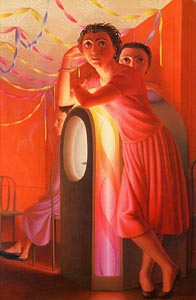 the Americas, including many connected with the Surrealism movement.
This development produced a mixture of curiosity, angst and
experimentation among American artists. Although many of the Surrealists
settled in New York City, when Breton arrived in 1941 he was unable
to remobilize the formal movement. Regardless, Surrealism had a
rather significant impact on American artists in the late 1930s and
early 40s, influencing the development of Abstract Expressionism,
and encouraging liberation from the prevailing attitudes that had
favored Regionalism.
the Americas, including many connected with the Surrealism movement.
This development produced a mixture of curiosity, angst and
experimentation among American artists. Although many of the Surrealists
settled in New York City, when Breton arrived in 1941 he was unable
to remobilize the formal movement. Regardless, Surrealism had a
rather significant impact on American artists in the late 1930s and
early 40s, influencing the development of Abstract Expressionism,
and encouraging liberation from the prevailing attitudes that had
favored Regionalism.
In 1943 an exhibition entitled "American Realists and Magic
Realists" was assembled at the Museum of Modern Art in New York by
Dorothy C. Miller. Many young artists who would help develop Magic
Realism were represented in this exhibition, including
Jared French,
Paul Cadmus,
Charles Rain and
Andrew Wyeth. Within a few years
George Tooker,
John Wilde, Henry
Koerner, Robert
Vickery, and Canadian
Alex Colville began to produce paintings
that we now think of as Magic Realism. All of these artists also
used Tempera techniques which date back to the Early Renaissance.
Their paintings were crafted as the meticulous objects of art, yet
their imagery was infused with metaphoric and symbolic elements.
Many of their paintings also featured
"surreal"
or dream-like nuances.
In the late 1940s and early 50s Magic
Realism flourished, distinguishing itself from other
movements such as Social Realism and
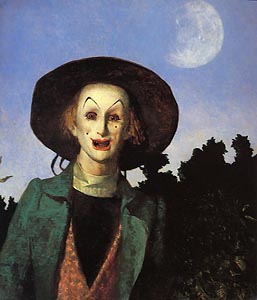 Surrealism. During this period
Magic Realism also helped to carry the banner of Realism, during the
heyday of Abstract Expressionism. Fortunately the work of the
American Magic Realists have received some due
recognition recently. The
art establishment of the day marginalized all representational art.
and only in the late 1960s the pendulum of tastes began to swing away from
abstract styles. However Photorealism and Hyperrealism, with a more
detached approach to content, became the preferred approach for a
new generation of artists. Surrealism. During this period
Magic Realism also helped to carry the banner of Realism, during the
heyday of Abstract Expressionism. Fortunately the work of the
American Magic Realists have received some due
recognition recently. The
art establishment of the day marginalized all representational art.
and only in the late 1960s the pendulum of tastes began to swing away from
abstract styles. However Photorealism and Hyperrealism, with a more
detached approach to content, became the preferred approach for a
new generation of artists.
The topic of Magic Realism in art has come up often in recent years,
as writers explore the origins of its use in literature and more recently in cinema.
Many observers have difficulty understanding that Magic Realism in
art differs from Magic Realism in literature, as the overtly fantastic
was excluded in art. Instead it depended on more subtle
twists of the quotidian. A simple explanation is that although
fantastic art has existed since the Renaissance, it was never
recognized as part of the mainstream until it developed a broader
market, which has began to blossom only within the past 50 years.
Franz Roh recognized the potential of the fantastic, expressing his
admiration for dreamers like Henri Rousseau and Walter Spies. But
meanwhile mankind was dealing with the fallout of two World Wars,
the Great Depression and the Cold War. During such trying times gravity
has a tendency to bring most art back down to earth.
Most of the important artists who produced Magic
Realism preferred to remain independent from the publicity and
controversies of established art movements. As Magic Realism had no
champion and no manifesto, both the general public and even many artists
were never quite clear about what the term meant. At the same time,
there is no doubt that a widespread current within representational
painting occurred in the four decades after World War I, which can
be distinguished from Expressionism, Social Realism, Surrealism and
other major movements of the first half of the 20th Century. Magic
Realism quietly grew from several commonalities among artists including an
affinity for the traditions of techniques, a love of art history and
from a shared collective consciousness. Most of its practitioners have now passed on,
but they have been left us their
great legacy.
The objective of this article is to presetn an overview of Magic
Realism as it developed as an art movement, and also to emphasize
that content is an essential component of Magic Realism paintings. A
list of artists
associated with Magic Realism follows below. This list is not exhaustive, but in order to get a better understanding of the
real essence of Magic Realism, it is recommended that you visit
these galleries and review the comments. It should be noted that in
many cases Magic Realism may represent only a small portion of an
artist's oeuvre.
Georg Kremer
- Email:
editor@monograffii.com
|
Images listed in
Descending Order (Click on Image for Enlargement) |
|
The Mountain
(1937) by Balthus |
|
Self Portrait as a
Clown (1921) by Max Beckmann |
|
Slilliben II (1922) by
Alexander Kanoldt |
|
Triglion (Imperial
Countess Triangi-Taglioni) (1926) by Christian Schad |
|
Die große
Hafenstadt - The Big Port (1928) by Herbert Reyl-Hanisch |
|
Ferruccio Ferrazzi,
Orizia agli specchi 1925 |
|
Shooting Gallery
(1931) by Pyke Koch |
|
Arnold Comes of
Age (Portrait of Arnold Pyle) (1930) by Grant Wood |
|
Jukebox (1953) by
George Tooker |
|
Automation (1979)
by James Wyeth |
Artists whose works have been associated with Magic Realism. A brief
overview of their paintings has been included.
| |
|
|
References / Recommended Reading: |
|
|
Magic Realism Rediscovered, 1918-1981,
Seymour Menton, Art Alliance Press, London, c1983
German Post-Expressionism, Dennis Crockett, The
Pennsylvania State University Press, 1999.
The
Uncanny, Nicholas Royle, Routledge, Taylor & Francis Group, New
York, 2003.
|
| |
|
|